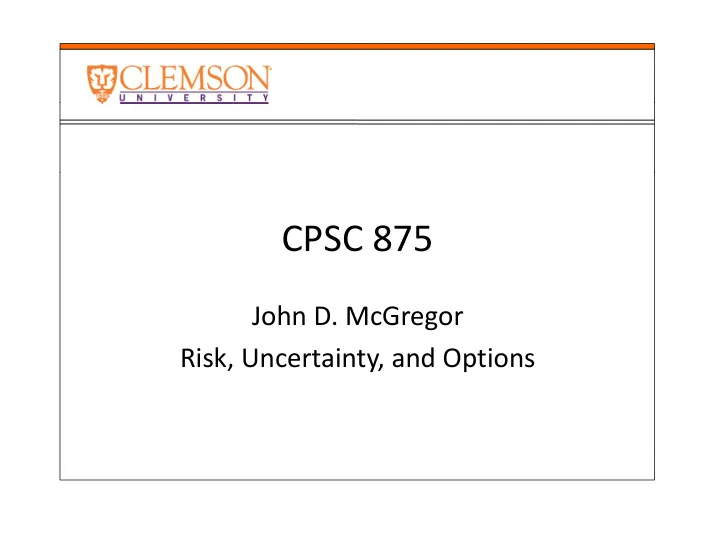

CPSC 875 CPSC 875 John D McGregor John D. McGregor Risk, Uncertainty, and Options
Dynamic environment Dynamic environment http://www.ignify.com/Ignify-eCommerce- Technical-Architecture.asp
Risk ‐ 1 Risk 1 • An event that could happen and if it did happen would cause pp pp a loss of value is a risk. • There are two major lines of mitigation: – Reduce the probability of occurrence – Reduce the cost if it does occur • There is a risk that the packet processing software will miss its • There is a risk that the packet processing software will miss its performance target resulting in loss of packets, unclear speech, and misunderstandings. Mitigation: simulate the architecture, measure actions required to process packets, propose alternative design, simulate and see if fewer actions are needed. are needed.
Risk ‐ 2 Risk 2 • One mitigation tactic is to design experiments One mitigation tactic is to design experiments. • More viable for software than hardware • To avoid impacting the project schedule the id i i h j h d l h entire region that might be affected by a d design decision can be factored into a module i d i i b f d i d l that can be replaced. • Then different designs can be created, measured, and the winner inserted without the rest of the design being impacted.
Risk 3 Risk ‐ 3 • Every experiment is the basis for an option Every experiment is the basis for an option • We can afford to run several experiments • But we need a notion of value d i f l • There is no point in spending more than the design is worth • Also there is the cost of a production quality p q y implementation once the choice is made
Acknowledgement Acknowledgement http://www.sei.cmu.edu/reports/07tr003.pdf
Definitions Definitions
Patterns Patterns
Questions addressed Questions addressed
Components of real options Components of real options
Approaches to real options Approaches to real options
Challenges ‐ 1 Challenges 1
Challenges ‐ 2 Challenges 2
Challenges ‐ 3 Challenges 3
Architecture for example Architecture for example
CIS as a real options problem CIS as a real options problem
Elicited values Elicited values
formula formula
So here is what you are going to do So here is what you are going to do • Examine your architecture for points of Examine your architecture for points of uncertainty • Develop an operational profile • Develop an operational profile • Return to a previous decision about a pattern to use • Consider the alternative patterns • Describe the considerations about each pattern as they relate to operational profile p y p p and uncertainty
Recommend
More recommend